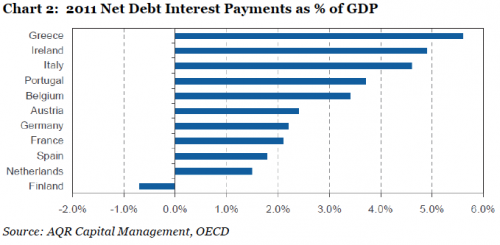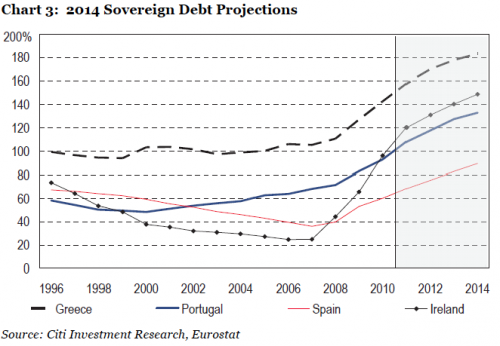In plain English this means that Greece would have to grow its nominal GDP by almost 6% per year going forward for debt-to-GDP not to rise further, assuming its average cost of debt remains stable (see chart 2). Ireland and Italy would have to grow by almost 5% and Portugal by almost 4%. With inflation hovering well below those levels in all the countries mentioned, that is a very tall order even during the best of times. And with austerity being forced upon all of these countries it is simply not going to happen.
How much is too much debt? There is no explicit formula as to when a country passes the point of no return as it is possible to live with high debt levels for extended periods of time. Take Japan which has lived with debt ratios well in excess of 100% for a number of years. It has been made possible through a combination of high domestic savings and extraordinarily low interest rates. However, Japan is a unique case. As a rule of thumb, when a country’s debt-to-GDP ratio exceeds 100% you are in dangerous waters.
The options available
Now, when a country finds itself in a Greek-style pickle, the options at its disposal are in fact quite limited. It can choose to:
(a) default on its obligations;
(b) negotiate lower interest rates in the face of a default (if possible);
(c) inflate (as higher inflation reduces the real value of its debt);
(d) reduce its deficit through austerity;
(e) take measures to stimulate economic growth; or
(f) any combination of the above.
In the case of Greece, inflating its way out is not an option as it doesn’t control its monetary policy. Meanwhile austerity, which has been the ‘chosen’ route so far, not only destroys economic growth (the opposite of what is needed); it is also deflationary which increases the real value of its debt.
It is perfectly understandable why the creditor countries demand austerity; it is just important to realise that, in the case of Greece, it destroys any hope of economic growth robust enough to avoid the debt trap discussed above. If you apply austerity to a competitive and export orientated economy such as Germany, domestic demand is likely to suffer, but exports may more than compensate for that. However, if you attempt the same trick on a largely domestic2 economy such as Greece, your ‘achievement’ will be limited to lowering both GDP growth and inflation, both of which will make an already bad situation a great deal worse.
Assuming that austerity eventually reaches a point where it is no longer politically tolerable – and I would suggest that Greece is there or thereabouts – you are left with only two options: Lower the cost of debt or default. Simple as that. It beggars belief that the creditor countries believe a solution can be achieved through austerity only. In the not so distant future the creditor countries will thus be faced with a simple choice: Offer more credit to Greece at much lower rates or face default. Given the emerging political landscape in Northern Europe where xenophobic political parties are fast gaining momentum, it could amount to political suicide for the mainstream parties to offer the former, which is why my money is on default.
The bigger picture
Now, let’s turn our attention to the bigger picture. Much noise has been made in the media about the contagion risk and why a default in Greece could spill over to other countries and force them into default as well. Citibank published a revealing research paper only a couple of weeks ago3 which clearly demonstrates why both Portugal and Ireland are on the path towards default regardless of what happens in Greece.
Under assumptions which seem quite reasonable Citibank concludes that whilst Greece is in the most desperate of situations with debt-to- GDP accelerating towards 180% over the next 3 years despite all the austerity being forced upon it, neither Portugal nor Ireland can realistically avoid a default with their debt-to-GDP growing to 133% and 145% respectively (see chart 3).













